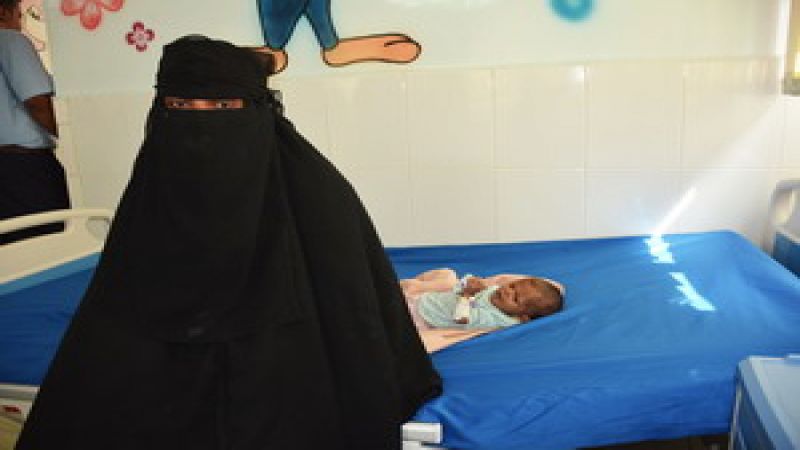
Local Editor
Wanisa is sitting beside her 7-month-old child, Soraya, anxious that she will meet the same fate as her older sister who died of severe malnutrition just a few days ago.
Wanisa brought her weak child to the WHO-supported stabilization center in Kamaran Hospital in Al-Marawia district, Hodeida governorate, seeking proper treatment. The newly established center provides treatment to children in need, as many families used to travel a great distance to Hodeida City to have their children treated.
“I cannot endure losing my other child. I’m doing everything I can to save her life,” she said. Like Wanisa, there are many families determined to get their malnourished children treated despite difficulties in accessing treatment and financial hardship. WHO is supporting the cost of caregivers’ meals during the time they have to stay with their children in the stabilization centers.
Isa Salah, 7 months, was brought from Sharis district in Hajjah governorate to Al-Jumhoori Hospital in Hajjah City. Enduring 5 miscarriages, the feeble mother looks too weak to be able to breastfeed her child.
“There is no health center in our district to treat my child. It is not easy for me to travel to this place but it is the only hope I have to keep my child alive,” she said.
A war that has brought on starvation
Yemen continues facing the double burden of high acute and chronic malnutrition. As the conflict continues unabated, the situation worsens, causing the list of malnourished children to increase daily. Currently, more than 1.8 million children under the age of 5 are acutely malnourished, including 500 000 children suffering from severe acute malnutrition, requiring immediate admission into therapeutic nutrition programs.
“The heartbreaking scenes of malnourished children in Yemen signal the catastrophic consequences of the conflict. I’ve seen children suffering from severe acute malnutrition with medical complications who really need special care and well-trained medical personnel,” said Dr Nevio Zagaria, WHO Representative in Yemen.
Responding to rising malnutrition rates in Yemen, WHO is providing life-saving treatment for children with severe acute malnutrition and medical complications. In 2017 alone, more than 4430 children under the age of 5 suffering from severe acute malnutrition with medical complications received treatment at WHO-supported stabilization centers.
WHO supports 47 centres, with 3 more planned in 2018, to cope with the rising needs for malnutrition treatment services.
On the brink of death
Many children have been brought to the WHO-supported stabilization center too late. The life of 5-month-old Ammar, suffering from brain atrophy, with 2.6 kg was saved in the stabilization center in Al Thawra Hospital in Hodeida governorate.
“Despite WHO interventions, there is much more that needs to be done to alleviate the pain of these children. The scale of suffering is unimaginable and requires concerted efforts and continuous support to meet the pressing needs,” said Dr Zagaria.
“These are concrete examples of the extreme cases of children, but this is only the tip of the iceberg of the many children who suffer. The international community and all the actors are doing their best but there is more that needs to be done together.”
With support from the World Bank and USAID/OFDA and the United Nations Office on the Coordination of Humanitarian Affairs (OCHA) Pooled Fund, WHO is setting up more stabilization centers, delivering more nutrition kits and training health workers on severe acute malnutrition case management.
Source: News Agencies, Edited by Website Team